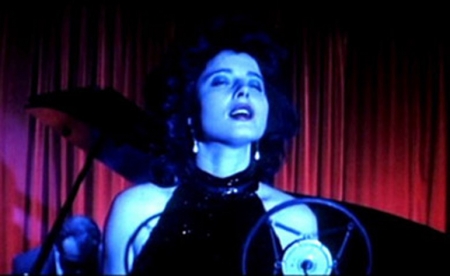This characters of Jeffrey and Frank are closely linked within the themes of surreal and dark because there are subtle links between them, the obvious is the fascination with Dorothy. Frank is the typical villian holding a member of the family hostage and raping the woman he is black mailing but the character also had a breathing disability which showed a sign of humanity. Frank was a mainly a character to be feared because even with the disability, there was presence and power when he entered the apartment scene and started to force Dorothy to satisfy his desires. There were hints that Frank might have been insaine, one example is when he is appling lipstick and kisses Jeffrey, which seemed to indicate that the character was a metaphoric monster as he was not afraid to unleash his dark identity on the other characters. Jeffrey is a detective but his job is put into question when he is found hiding in the closet of Dorothy's apartment, which looked like he was a pervert. This means that the most honourable men could be twisted within the dark mean changing the perception of what there intentions are. Sandy discovered that Jeffrey was close with Dorothy and her perception of what kind of person he is changed, symbolising something dark that was conceallled has now been revealed into the open. 'some ways, the two male leads represent the two dichotomous sides of life (e.g., light/dark, normalcy/aberration, attraction/repulsion, innocence/expriences, perversion/love, virtue/base desires, etc.) that struggle for dominance' (Dirks, 2010), the quote explains how the line between opposites are crossed so that a particular scene could have a hidden dark meaning.
Figure 1, 2010, Frank blackmailing Dorothy
There was a sense of eerieness in the sets because there were two time periods merged together. The houses were nineteen sixies but apartment set was designed as it would of looked in the eighties, this clash created a fantasy America with conflicting themes. Lynch is famous for making his films dark and twisted but this film was a lot more subtle because real themes were slightly bent to fit the theme of the story. 'And so begins Blue Velvet, an abrasive, original look at violent and perverted behaviour that could have only come from the mind of David Lynch' (French,2001), this evidence implies that Lynch focusses on the dark perception on very basic real themes and that he creates a fantasy world around this to create disturbing and uncomfortable tension. An example is violence because a lot of films would usuallly show the excitment and the thrill that comes from the adreline but this film focussed on capturing the horror and evil that it really is. The closet where Jeffrey hides to spy on Dorothy has a great cropped view so that he could only see a sliver of the space. Also the use of little light pouring through the slits on the door really made the space feel small and claustrophobic. The scene where Dorothy is left naked on the lawn has a simliar appearance to a Gregory Credson photograph because it was at night and if the purpose was not known, it could create a lot of meanings around the themes of abandonment and protestution.
Figure 2, 2011, Jeffrey hiding in closet
Figure 3, 2007, Dorothy's apartment
The song 'Blue Velvet seemed to a flowing connection throughout because it was the only song Dorothy would sing in the bar as if their was some personal connection. The song also effected Frank emotionally because in one scene he is crying so this could mean he had a deep connection with the song or a syptom of his insainty that relaxes him. Even the soundtrack would play the song Blue Velvet at the points in the film where Jeffrey and Dorothy were making love or kissing. The rest of the soundtrack was strong keeping to the rules of the two separate rules of the two eras. The songs for the sixties city was calm and represented everyday life but the track for the apartment scenes built up tension and typical for an eerie space.

Figure 4, 2010, Dorothy singing
The ending was disturbing because it was perfectly tied up and 'they all lived happy after' scenerio, which is not expected in a Lynch film. It was depicted as if the experience hasn't effected either Jeffrey or Sandy, especially considering some of his hidden secrets with his dealings with Dorothy but they seem oblivious to this. However when all the characters stop to stare at a bird perched outside the window, it looks like it is made from clock work, identifying that this perfect world could be another fake creation. It also indicates that this world has the potiential of turning dark and falling into a twisted surreal dream. 'The time period is unsettled. It more or less seems to be taking place in the present day, but it mashes together elements from several eras.' (Hanke 2010), Hanke sums up how the themes could appear confusing to a viewer in Lynch' s clever twisted style and therefore implies how this ending has alot of hidden dark elements that have not quite revealed themselves in the open.
Illustrations
Figure 1, Visible Justin, (2010), Frank blackmailing Dorothy, @ http://mubi.com/topics/12795, Accessed on: 30th June 2010
Figure 2, Richards Deke, (2011), Jeffrey hiding in closet,@ http://www.posterpalace.com/categorysearch.lasso?-Token.category=mystery, Accessed on: 2011
Figure 3, Day Borris, (2007), Dorothy's apartment, @ http://www.flickr.com/photos/19971779@N00/358808656, Accessed on: 15th January 2007
Figure 4, Parks Matthew, (2010), Dorothy singing, @ http://mubi.com/topics/12795, Accessed on: 2008
Bibliography
Dirks Tim, (2010), Film site, @ http://www.filmsite.org/blue.html, Accessed on: 1st January 2000
French Blake, (2001), Filmcrictic.com, @ http://www.filmcritic.com/reviews/1986/blue-velvet/, Accessed on: 25th October 2001
Hanke Ken, (2010), Blue Velvet(R), @ http://www.mountainx.com/movies/review/blue_velvet, Accessed on: 30th June 2010






No comments:
Post a Comment